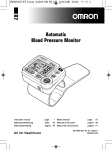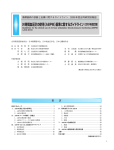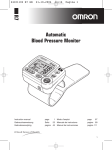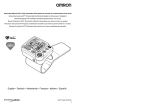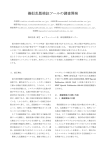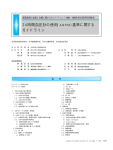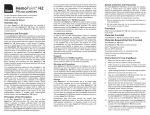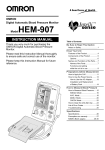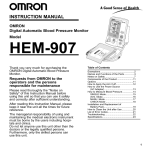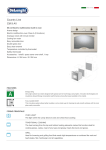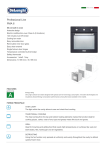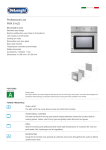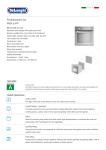Download Omron Healthcare R5 User's Manual
Transcript
Instruction Manual !"
Automatic Wrist Blood Pressure Monitor
!"#$
Model
R5
• Thank you for purchasing the OMRON Automatic Wrist Blood
Pressure Monitor.
• Please read this Instruction Manual thoroughly before using.
• Please keep this Instruction Manual at hand for your future
reference.
• • • !" OMRON !"#$%
!"#$%&'()
!"#$%&'()*+
1
OMRON-R5 (CT)
1
27/11/03, 14*06
!"#$%
• • • ! ............................................................................ 3-4
! ............................................................................... 5
!"#$% .............................................................. 6-8
!"#$%
• • !"#$% ............................................................ 9-10
!"#$% .......................................................... 11-12
!"#$
• .....................................................................................
• !" ..........................................................................
• ! .............................................................................
• .....................................................................................
!"#$
• • • !"#$%&'() ................................................. 17
!"#$% ............................................................... 18
!"# ...................................................................... 19
2
OMRON-R5 (CT)
13
14
15
16
2
27/11/03, 14*06
!
!"#$%&
!"#$%&'()*+,-./01
!"#$%&
• !"#$%&'()
• !"#$%"#&'()*+,-./01234567
!"#$%&'()*+,-./0123$45667
!"#$%&'($%&)*+,-. !"#
!"#$%&'()*+,-. 20 mmHg !
!"#$%&'()*+,-./012345-6
• !"#$%&'()*+,-./'01234567
!"#$" ! !"#$%& '()*+,
!"#$%&'()*+,-./0123
• • • • !"#$%&'()*+,-+./
!"#$%&'()*+,
!"#$%&'()*
+,
!"#$%&'()
!"#$%&'()*+,
!"#$%&'()
!"#$%&'()*+
!
!"#$%&'
3
OMRON-R5 (CT)
3
27/11/03, 14*06
!
•
•
•
•
!"#$
%&'()*+,-./01234
!"#$%&'( !"#$%&
!"#$%&'()$%*
!"#$%&'
!"#$%&'()*+
!"#$
!"#$%&'()
!"#$
!"#$%&'(
!"#$%&'()*+,-.,-/,
!"#$%&'()*+!,-./0
!"#$%&'$()*+#,-./01
%&'()*+,-./*01
BENZINE THINNER
GASOLINE
4
OMRON-R5 (CT)
4
27/11/03, 14*10
!
!
!"
!
!"
!
!
!"#$
AAA LR03
!
INTELLISENSE !" !"#$%&'()*+
!"#$%&'()*+,*-.%&/0123OMRON
!"#$%&'!"()*+,-./01234#
5
OMRON-R5 (CT)
5
27/11/03, 14*10
!"#$%
!
(1) !"#$%&
(2) !"#
1 2
(3) !"#$%&'(
+ – !"
4
(4) !"#$%&'(
!"#
• 3
!"#$
!"#!$% AAA ! 22°C !"
! 170 mmHg !"#$%&'() 400 • !"#$%&'()*+,-.%/0 !1+22°C
!"#
• !"#$%&'()*+$,-./0/12 400 • !"#$%&
!"#$%&'()*+%,-.
!"#$%&'()*+,-.+,/
• !"#$%&'(")*+,-+./012345678
!"#$%#&'()*+,-./01234!5
• !"#$%&'()*
+ !"#$%&'(
6
OMRON-R5 (CT)
6
27/11/03, 14*11
○
○
○
○
!"
○
○
○
○
○
○
○
○
○
○
!"#$%
○
○
○
○
○
○
○
* * 1. !"#$%&'
!"#$
○
○
○
○
○
○
○
○
○
○
○
○
○
○
○
○
○
○
○
○
○
○
○
○
○
○
○
○
○
○
* !"#$%&
!"#$%&
10~15 !
10 - 15mm
○
○
!"#$%&'()*
!"#$%&'$(
○
○
○
○
○
○
○
○
○
○
○
○
○
2. !"#$%&'()"*+,-./'01
!"#$%&'
* !"#$%&'()*+
!"#$%&'()*
* * * ○
○
○
!"#$ !"#$ 145 !"#$%&'
!"#$%&'()*+,-.(/0#)1234"
!"#$%&
!"#$%&'()*+,-./
○
○
○
○
○
○
○
○
○
○
○
○
○
○
○
○
○
○
○
○
○
○
○
○
○
○
○
!"#
!"#$%&'()*+
!"#
7
OMRON-R5 (CT)
7
27/11/03, 14*30
○
○
○
○
○
○
!"#$%
!"#$%&'()*+,-./001234
○
○
○
1. ○
○
○
○
○
○
○
○
○
○
○
○
○
○
○
○
○
○
○
○
○
○
○
○
○
○
○
○
○
○
○
○
○
○
○
○
○
○
!"#$%&'()*+,
* !"#$
2. !"#$%&'()*
3. !"#$%&
!" !
* ○
○
○
○
○
• !"#$%
○
○
○
○
○
○
○
○
○
○
○
○
○
○
○
○
○
!"#$%&'(
* !"#$%&
!"#$%&
!"#$%
* !"#$%&'
!"#$%
8
OMRON-R5 (CT)
8
27/11/03, 14*30
!"#$%
!"#$%&'()*+,-./012%34567%89
!"#$
○
○
○
○
○
○
○
○
○
○
○
○
○
○
1. !"#$%
(1) !"#$%&
!"#$%&'
○
○
○
○
○
○
○
○
○
○
○
○
○
○
○
○
○
○
(2) !"
!"#$!"%&
0.5 * !
!"
!"#$%&'
(3) !"
!"#$
(4) !"#$%&'
* !"#$%&'()
!"#$%&'()
!"#$%&'(
!"#$%&'()*+
!
9
OMRON-R5 (CT)
9
27/11/03, 14*30
○
2. !"#$%
!"#$%&'()*+,-
!"#
!"#$%&'()*+,
!"#$%&'()*+,- ./
!"#
* * ○
○
○
!
!
!"#$%&'()*+,- !" 15 !"#$%&'()*+,-.7 !"#$%&'
!"#$%&'(
○
○
3. ○
○
○
○
○
○
○
○
○
○
○
○
○
○
○
○
○
○
○
○
○
○
○
○
○
!"
!"#$%&'(
!"#$%&'()*
!"#$%&'() 1 * !"#$%&'()*+, 2 !"#$%
10
OMRON-R5 (CT)
10
27/11/03, 14*44
○
○
○
R5 ○
○
○
○
!"#$%&'()*+,
○
1. !"#$%
○
○
○
○
○
○
○
○
○
○
○
○
!
M
○
○
○
○
○
○
○
○
○
○
○
○
○
○
○
○
!"
!"#$%&'"#()*+,-+./01
!"#$%&'(
M
!M
!"#$
!"#$
M
!"#$%&'()*+
!"#$%&'()*+
!"#$%&' !
!"#$%&'()*
* !"#$%&'()*+,-./0#)123M
!"#$%&'M !"#$%&'()*
!"#$%&'
* !"#$%&'()*+
* ! !" !"#$%!&'$()*+,
11
OMRON-R5 (CT)
11
27/11/03, 14*44
!"#$%
2. !"#$%&'()
!"#$%&'#$(
!"#$%&'()*
!"#$%
* !"#$%&'()*+, 2 !"#$%
* !"#$%&'"#()*+,-./012)34)56
○
○
○
○
○
• ○
○
○
○
○
○
○
○
○
○
○
○
○
○
○
○
○
○
○
○
○
○
○
○
○
○
○
!"#$ !"#$%&'()*+,
(1) !"#$%M !"
!"
(2) M !" #
START/STOP !"#$%
* !"M
!"#$%&'(
!"#$%&'M
!"
(3) M !"#$%&'(
M
(4) M !"#$%&'()
!"#$%&'()*!'(
!"#$%&
(5) START/STOP !"#$
!"#$
!"#
12
OMRON-R5 (CT)
12
27/11/03, 14*45
○
!"#$
!"#$%&'()*
!"#$%&'(&)
* !"#$%&'()*+
!"#$%&'()*
!"
BENZINE THINNER
GASOLINE
!"#$%"#&'(
!"#$%&'()*
!"#$%
!"#$
!"#$%&'()*
!"#$%&'
!"#$%&
!"#$%&'()*
13
OMRON-R5 (CT)
13
27/11/03, 14*57
!"
!"#$%&'()*+
!"#
!"#
!"#
!"
!"#
!"#
!"
!"#
!
!"#$%
!"#$%
!"#$
!"#$
!" 9
!
!
* !" ! !"#$
!"#$
!"#
!"#
!" 6 !"#
14
OMRON-R5 (CT)
14
27/11/03, 14*57
!
!"#$%&'()*+,-./0123
!"#$%&
!"#
!
!"#$
!
!"
!" 6
!"#$%&
!"#$%&'( !" 6 !"#$%&'( ! " # $ % &
!" 8 !"#$
!"#$
!"#$
7 !
!"
!"#$%&'
!"#$%&'( !"#$%
8 !"#$%&'( !"#
!"#$%&'
!"#$% E !
!"#$
!"#$% ! 17 18 OMRON !
!"#$%&
8 O M R O N !
!"#$%&'()*+
!"#$%&' !"#$%&'()*"#$+%,-.,
!"#$%&' !"#$%#&'()*+ !" 17
18 * !"#$%&'()*+,-./012/03456
* !" OMRON !"#$%&'()*+,-./
* !"#$%&' ()*+,-./01+2345$6&'7
!"#$%
15
OMRON-R5 (CT)
15
27/11/03, 14*58
!
!
OMRON !"#$
R5
!"
!"
0 ~ 280 mmHg
!"# 40 ~ 180 !" ±4 mmHg !"#$% ±5% !"#
!"#
!"#!
!"#!
!"#
!"#$%&'(
AAA LR03
22°C !"#$%&'()*"
!" #$% 170 mmHg ! 400 !
±10°C ~ +40°C 30 ~ 85% RH
-20°C ~ +60°C 10 ~ 95% RH
!"#$%
!"#
!
135 ~ 215 130 !"#$
54 x 68 x 32.5
!
!"#$
!"
B !"#$
!"# AAA !"#$%&
* !"#$%&'()
16
OMRON-R5 (CT)
16
27/11/03, 15*11
!"#$%&'()
!"#$%&'()*+,-.!"#/0
!"#$%&'3050 mmHg
!
!"#$%&'()*+
!"#$%
!"
(mmHg)
!"#$%&'()*
!
!
!"#$%
!"Osamu Tsuchikubo !"#$%&' ()%*+,
!"#$%&'()*+,!"#- 25~30
mmHg !"#$%&'()*+,-./0
!"#$% &'()*+,-./'
!"#$%&'()*+,'-./012
30~50 mmHg !
!"#$%&
• • • ! • • !"#$% • • • • • • !
!"#$%&'()*"+,-./01
17
OMRON-R5 (CT)
17
27/11/03, 15*11
!"#$%
!"#$
!"#$%&'()*+,-./$01%&23)456#
!
(1) !"#$%&'(
!"#$%&'(
!"#
!"#
!"#
!"
(2) !"#$%&'(
!
(3) !"#
!"#
!"#
!"
(4) !"#$%&'(
!"#$%&'(
!"#$%&'()*+,-./
!"#$%&'()*+,-./
!"#$%&'()*+,"#!"#$%&'()*+,-
!"#$%&
!
!
!
!
!
!"'()*+
!"#$%& !%'(
!"#$%&'()*+,
!"#$%&'()*+,
!"#$%&'()*#)
!"#$%& ±10 mmHg !"#
!"
±10 mmHg !"#$%& !"#$%&'($%)*+,-./012
!"#$%&'()*+,-./0123451634789:
!"#$%&'()*+,-./012!3456789:;<
OMRON !
18
OMRON-R5 (CT)
18
27/11/03, 15*17
!"#
!"#$%&'()
!"#WHO !"#$%ISH !"#$%
!"#$%&'
!"#$%&'()*+,&-.&/0123
* !"#$%&'()*+,-./01234536789-.,:
100 mmHg !"#$%&'(
!
(mmHg)
!"
180
!"
160
!"
140
130
120
!"
!"#
!"#
!"
80
85
WHO/ISH* 90
100
110
!
(mmHg)
!"#$%&'()
* ISH !"#$%
19
OMRON-R5 (CT)
19
27/11/03, 15*17
OMRON-R5 (Eng)
11/27/03
10:48 AM
Page 2
Table of Contents
Before Using this Monitor
• Notes on Safety . . . . . . . . . . . . . . . . . . . . . . . . . . . . . . . . . . . . .3-4
• Name of the Parts . . . . . . . . . . . . . . . . . . . . . . . . . . . . . . . . . . . . .5
• Preparation before Use . . . . . . . . . . . . . . . . . . . . . . . . . . . . . . .6-8
Correct Use of this Monitor
• How to Measure Blood Pressure . . . . . . . . . . . . . . . . . . . . . . .9-10
• How to Use the Memory Function . . . . . . . . . . . . . . . . . . . . .11-12
How to Care for this Monitor
• Maintenance . . . . . . . . . . . . . . . . . . . . . . . . . . . . . . . . . . . . . . . .13
• Error Indicators . . . . . . . . . . . . . . . . . . . . . . . . . . . . . . . . . . . . . .14
• Troubleshooting . . . . . . . . . . . . . . . . . . . . . . . . . . . . . . . . . . . . .15
• Specifications . . . . . . . . . . . . . . . . . . . . . . . . . . . . . . . . . . . . . . .16
A Few Words about Blood Pressure
• What You should know about Blood Pressure . . . . . . . . . . . . . .17
• For the Correct Measurement of Blood Pressure . . . . . . . . . . . .18
• Blood Pressure Classification . . . . . . . . . . . . . . . . . . . . . . . . . . .19
2
OMRON-R5 (Eng)
11/27/03
10:48 AM
Page 3
Notes on Safety
Please observe the following safety notes
Caution
Self-diagnosis of measured results and treatment is dangerous.
Please follow the instructions of your doctor.
• Self-diagnosis may worsen the disease.
• Diabetes, hyperlipemia, or hypertension may lead to arterial sclerosis. If
the conditions are not checked, there is an increased danger of cerebral
apoplexy or myocardial infarction, or arteriarctia or peripheral circulatory
disturbances. In such cases, wrist and brachial blood pressure may
differ greatly. (Even for the healthy person, there may be a difference of
20 mmHg if the measuring conditions are not appropriate. Therefore, do
not diagnose the measured results by yourself. Consult your doctor and
ask for his/her instruction.)
• The difference between wrist and brachial blood pressure values may be
due to physiological conditions at the time of measurement. However,
blood pressures measured at the wrist and those at the brachium (upper
arm) fluctuate in the same manner. Therefore, you can also check
fluctuation tendency by measuring blood pressure at your wrist.
Do not use with infant or person who cannot express one's
intention.
• This may lead to accident or trouble.
Do not use for purposes other than to measure blood pressure.
• May lead to accident or trouble.
Do not use portable phones near this monitor.
• The monitor may operate erroneously.
Do not disassemble or modify the main
unit or the wrist cuff of the blood
pressure monitor.
• Correct measurement will be impossible.
3
OMRON-R5 (Eng)
11/27/03
10:48 AM
Page 4
Notes on Safety
Please take note
Worn battery may leak and damage the main unit. Please observe the
following.
• When you are not going to use this monitor for a long period of time
(approximately three months or more), remove the batteries.
• Replace worn batteries with new ones immediately.
• Do not use worn and new batteries together.
• Do not insert batteries with their polarities in the wrong direction.
Do not use force to stretch or bend the wrist cuff.
Do not press the START/STOP button when the cuff is not
wrapped on the wrist.
Do not apply shock or drop the monitor.
Do not store the monitor under direct sunshine, where
there is high temperature and humidity, dust, contact with
corrosive gases or water.
Do not use benzine, thinner, gasoline, or alcohol to clean
the monitor.
4
BENZINE THINNER
GASOLINE
OMRON-R5 (Eng)
11/27/03
10:48 AM
Page 5
Names of the Parts
Main unit
Systolic Blood
Pressure Display
Pulse Display
Wrist Cuff
Memory Button
Diastolic Blood
Pressure Display
START/STOP Button
Battery Cover
Accessories
Two AAA Alkaline
batteries (LR03)
Storage case
INTELLISENSE blood pressure monitor is a global brand name of
blood pressure monitor equipped with bio-information sensing and high
performance fuzzy logic technology, which are the key technologies of
OMRON. With this excellent sensing technology, the monitor can
achieve accurate measurement.
5
OMRON-R5 (Eng)
11/27/03
10:48 AM
Page 6
Preparation before Use
Insert the batteries.
(1) Pinch the sides of the battery
cover.
1 Pinch
(2) Pull out the battery cover.
2
(3) Insert the batteries by matching
the polarities (+ and -).
4
(4) Replace the battery cover by
pinching it with finger tips.
3
Battery life and replacement:
• With the use of high performance alkaline batteries (two AAA batteries),
you can measure approximately 400 times if you use this monitor at room
temperature of 22°C and inflate it to 170 mmHg, three times a day.
• The battery life varies with the ambient temperature. At low temperature
such as during winter, battery life is shortened compared with the normal
temperature of 22°C.
• The batteries included are for monitoring only and may not last 400 times.
• If the battery replacement mark
flashes, or if the monitor does not
inflate when the START/STOP button is pressed, replace the two
batteries with new ones of the same type.
• If you hold down the START/STOP button, batteries will wear out. Keep
the monitor in the storage case when carrying or storing to avoid pressing
on the START/STOP button.
• Replace the batteries while the power is turned off (when nothing is
displayed).
6
OMRON-R5 (Eng)
11/27/03
10:48 AM
Page 7
Preparation before Use
Attach the Wrist Cuff.
1. Place the wrist cuff
over your left wrist with
your left thumb facing
upward.
* Wrap the wrist cuff over bare
skin.
* Be sure not to roll the sleeve of
your shirt into the wrist cuff.
* As shown in the
10 - 15mm
Figure, leave a space
of 10 to 15 mm (about
the width of an index
finger) between the
edge of the wrist cuff
and the palm.
2. Hold the bottom part of the wrist cuff and wrap it
around the wrist while pulling so that it fits snugly.
* Unless the wrist cuff is wrapped
snugly, correct measurement
may not be possible.
* For the slender wrist (wrist circumference of less than 145 mm), the wrist cuff
may not be wrapped snugly and give a feeling of loose wrap. In this case, do not
force to wrap since the measurement is not affected.
* Fasten the Velcro tape tightly.
* The remaining part of the wrist cuff can be conveniently folded back out of the way.
When measuring on the
right wrist
Measurement can also be made on
the right wrist. Fit the monitor as
shown in the Figure.
7
OMRON-R5 (Eng)
11/27/03
10:48 AM
Page 8
Preparation before Use
Align the wrist cuff with the level of your heart and
gently support your left hand with your right hand.
1. Sit on a chair in correct posture with your back
straight.
* Do not bend your body forward.
2. Take deep breaths five to six times, then relax.
3. Align the wrist cuff
to the level of your
heart. (Refer to the
Figure to the right.)
* Fingers touching the
shoulder in this position.
• Measuring postures and hand shapes you should avoid
* If the wrist cuff is lowered
or you hold your hand too
tight, blood pressure
values may be measured
as higher than usual.
* Do not support the wrist
cuff with your right hand. It
will cause erroneous
measurement.
8
OMRON-R5 (Eng)
11/27/03
10:48 AM
Page 9
How to Measure Blood Pressure
When it is ready to measure, take the measurement in the following
procedure. To start measurement, simply press the START/STOP button.
1. Press the START/STOP button.
(1) Press the START/STOP
button.
Release the Button when
the display turns on.
(2) Initial display.
All display symbols turn on
for about 0.5 seconds.
* The battery replacement mark
shown here does not
mean batteries are worn out.
(3) Deflation display.
A
mark starts to flash.
(4) The monitor starts to inflate
and measure.
* Because measurement is
made during inflation, do not
move your hand, wrist, or arm
after the monitor starts to
inflate.
These marks disappear one by one
as the measurement proceeds.
9
OMRON-R5 (Eng)
11/27/03
10:48 AM
Page 10
How to Measure Blood Pressure
2. Measurement is over and blood pressure values and
pulse are displayed.
When the measurement is over, a
mark flashes, and the cuff
deflates automatically. Then a
mark turns on and blood
pressure and pulse rate are displayed simultaneously.
Display of measurement results
Systolic Blood Pressure
Diastolic Blood Pressure
Pulse
* If a measurement cannot be made or the blood pressure values are
displayed abnormally high (low), refer to Page 15.
* If the Velcro tape comes off during the measurement, wrap the wrist cuff
snugly as shown in Page 7 and measure again after fastening the Velcro
tape.
3. Turn off the power.
Blood pressure measurement is complete now.
Press the START/STOP button to turn off the power.
To make another measurement, repeat the procedure in Step 1
above.
* Even if you forget to turn off the
power, the monitor will turn off
automatically in approximately 2
minutes.
10
OMRON-R5 (Eng)
11/27/03
10:48 AM
Page 11
How to Use the Memory Function
The R5 Blood Pressure Monitor can record up to seven measurements.
1. Press the MEMORY button ("M" button).
The measurement values can be recalled after completion of the
measurement or even when the power is off.
The latest measurements are
displayed.
Press the "M" button.
Each time the "M" button is pressed,
the previous measurement values are
displayed.
Press the "M" button.
When all the stored measurement
results are displayed, the display of the
present measurement result or the first
measurement result will resume (if the
memory is recalled when the power is
off.)
* Immediately after completion of the measurement, the memory may not
be called even by pressing the "M" button. In that case, leave the finger
from the "M" button and press it again to call the memory.
* You can recall up to seven measurements.
* Memory capacity is maintained in a "first-in-first-out" basis, ie the oldest
readings will be deleted first.
11
OMRON-R5 (Eng)
11/27/03
10:48 AM
Page 12
How to Use the Memory Function
2. Press the START/STOP button to turn off the power.
After reading the blood pressure
values and pulse rate stored in the
monitor, press the START/STOP
button to turn off the power.
* Even if you forget to turn off the power,
the monitor will turn off automatically in
approximately 2 minutes.
* The stored measurements will remain in the memory even when the
batteries are removed for battery replacement.
• To delete the memory (Everything in the memory will be deleted.)
(1) Press the "M" button while the power is off
to call the measured data.
(2) Press the START/STOP button for more
than 2 seconds while pressing the "M"
button.
* If you press the "M" button first, the power will
turn off.
The display appears as shown to the right
and the "M" button starts blinking.
(3) When the "M" mark starts blinking, stop
pressing the "M" button.
(4) When the "M" mark stops blinking, the
contents of the memory are deleted and
the display of no memory appears.
(5) Press the START/STOP button to turn off
the power.
Memory being deleted
Display of no memory
12
OMRON-R5 (Eng)
11/27/03
10:48 AM
Page 13
Maintenance
How to clean the monitor
Wipe the monitor with a cloth,
moistened with water or detergent, then
wipe it dry with a dry cloth.
* Please be careful so that water do not
get into the unit.
Do not use benzine, thinner, or
gasoline to clean he monitor.
BENZINE THINNER
Do not wash or wet the wrist cuff.
Even if the cloth lining inside the
wrist cuff becomes fluffy, it does
not affect the measuring
accuracy.
How to store the monitor
Keep the main unit in the
storage case when carrying or
storing the monitor.
If you are not going to use the
monitor for a long period of time
such as for more than three
months, remove the batteries
from the monitor to prevent
leakage.
13
GASOLINE
OMRON-R5 (Eng)
11/27/03
10:48 AM
Page 14
Error Indicators
If measurement is not made correctly, the following error will be
displayed.
Error
Cause
How to correct
You moved
your arm or
body, or talked
during
measurement.
Press the
START/STOP
button once to turn
off the power.
Measure your blood
pressure again
without moving
your arm or body.
(Refer to Page 9.)
After several
seconds
You moved
your arm or
body greatly
during
measurement.
After several
seconds
Batteries are
worn out.
Replace the
batteries with new
*Display of battery ones. (Refer to 6.)
replacement
mark during the
initial display
does not mean
worn batteries.
Only mark flashes.
14
OMRON-R5 (Eng)
11/27/03
10:48 AM
Page 15
Troubleshooting
If trouble occurs while you are using the monitor, check the following points first.
Trouble
Nothing is displayed
when you press the
START/STOP button.
Measurement cannot
be made.
Or, blood pressure
values are displayed
abnormally high (low).
What to check
How to correct
Are the batteries worn
out?
Replace the batteries
with new ones. (Refer
to Page 6.)
Are the polarities of
batteries wrong?
Insert the batteries with the
polarities in correct
direction. (Refer to Page 6.)
Did you keep the wrist
cuff at the same level
as your heart?
Measure your blood
pressure in the correct
posture. (Refer to Page 8.)
Is the wrist cuff
wrapped snugly?
Wrap the wrist cuff
correctly. (Refer to
Page 7)
Are you putting too
much stress on your
shoulder or arm?
Relax, and measure.
(Refer to Page 8.)
Are you talking or
moving your hands
during measurement?
Keep still and measure
again.
(Refer to Page 8.)
The wrist cuff does
Is the wrist cuff leaking
not inflate to the
required pressure and air?
an E is displayed.
Ask for the repair.
The blood pressure
values differ from the
brachial pressures.
After referring to the section on pages 17 to 18,
consult the nearest OMRON dealer.
Blood pressure value
differs each time I
measure or the blood
pressure value is
displayed abnormally
high (low).
Blood pressure value varies according to the
mental state during measurement or the
measuring time. Take a deep breath, relax, then
measure again. (Refer to Page 17 to 18.)
* If you cannot measure your blood pressure correctly even after taking the above mentioned
measures, the monitor may have malfunctioned.
* To confirm the problem or request for repair, consult the nearest OMRON dealer.
* In some very rare cases, some error may be caused by the physical natures. In such a case,
please consult the doctor.
15
OMRON-R5 (Eng)
11/27/03
10:48 AM
Page 16
Specifications
Name
: OMRON Automatic Wrist Blood Pressure
Monitor
Model
: R5
Display
: Digital display
Measurement
: Oscillometric method
Measurement Range : Pressure; 0 to 280 mmHg
Pulse rate; 40 to 180 beats/min
Accuracy
: Pressure; Within ±4 mmHg
Pulse rate; Within ±5% of reading
Inflation
: Automatic inflation by pumping
Deflation
: Automatic rapid deflation
Pressure Detection
: Electrostatic capacity semiconductor
pressure sensor
Power supply
: Two AAA batteries (LR03)
Battery Life
: Approximately 400 measurements when
using alkaline batteries at the room
temperature of 22°C and by using three
times a day and inflating to 170 mmHg
Operating Temperature : +10°C to +40°C, 30 to 85% RH
and Humidity
Storage temperature
: -20°C to +60°C, 10 to 95% RH
and humidity
Measurable
circumference of wrist : 135 to 215 mm
Weight of Main Unit : Approximately 130 g (not including batteries)
External Dimensions : 54 (W) x 68 (H) x 32.5 (D) mm
(not including the wrist cuff)
Electric Shock
Protection
Accessories
: Internal power supply appliance type B
: Storage case, two AAA alkaline batteries,
Instruction manual
* Specifications may be changed without prior notice.
16
OMRON-R5 (Eng)
11/27/03
10:48 AM
Page 17
What you should know about Blood Pressure
Blood pressure values measured at home tend to be
lower than those measured at the doctor's office.
Blood pressure can vary by as much as 30 to 50 mmHg depending on
whether you are nervous or relaxed.
Blood pressure fluctuations throughtout the day.
(Direct measuring method)
Blood pressure
(mmHg)
Dinner
Sleep
Breakfast
Lunch
Rest room
Systolic
blood
pressure
Diastolic
blood
pressure
Time
Brachial blood pressure data
Provided by Dr. Osamu Tochikubo of the Second Internal Medicine,
the Faculty of Medicine at Yokohama Municipal University.
Blood pressure values measured at home are sometimes
25 to 30 mmHg lower than those measured at the doctor's
office. This is caused by the fact that you may be nervous
at the doctor's office, but are relaxed at home. It is
important to know your regular normal blood pressure
measured at home.
Factors that may cause the blood pressure to fluctuate
• Breathing • Exercise • Mental stress • Concern
• Environmental and/or temperature change • Eating
• Urination and bowel movement • Conversation • Taking bath
• Drinking alcohol • Smoking, etc.
Please understand that blood pressure fluctuates easily as shown above.
17
OMRON-R5 (Eng)
11/27/03
10:48 AM
Page 18
For the Correct Measurement of Blood Pressure
Let's Measure Blood Pressure Correctly.
It is important to observe the correct measuring method in order
to measure blood pressure accurately.
(1) Take a correct posture so
that the wrist cuff is at the
same level as the heart.
If your finger
touches the
shoulder, it is
the right level.
(2) Be sure to sit on a chair
and take a correct posture.
(3) Relax yourself
by releasing
the tension
from shoulder
and arm.
(4) Wrap the wrist cuff snugly.
Learn your blood pressure trend
In order to know the fluctuation trends of your
blood pressure, it is important to measure your
blood pressure at the same time every day at
home and recording it.
Furthermore, do not worry about your blood
pressure each time you measure. Ask your
doctor to interpret your blood pressure data.
During the
measurement,
do not stare
at the display
but look at
something at
far.
Wrist blood pressure may differ from brachial pressure.
Wrist blood pressure is measured at a
different region from the usual brachial
For the healthy
people, the
blood pressure measurement and may
difference is
show slightly different value. In many
approximately
cases, the difference between the wrist
±10 mmHg.
and the brachial blood pressures is
approximately ±10 mmHg both for the
systolic and the diastolic pressures in the case of healthy people.
People with the following condition should take note. When arterial
sclerosis worsens because of diabetics, hyperlipemia, or hypertension, it may
cause peripheral circulatory disturbance. In these cases, the wrist and brachial
blood pressure values may differ greatly. If you have any question on the blood
pressure values measured at wrist, please contact the nearest OMRON dealer.
18
OMRON-R5 (Eng)
11/27/03
10:48 AM
Page 19
Blood Pressure Classification
Classification of Blood Pressure by the World Health
Organization
The World Health Organization (WHO) and the International
Society of Hypertension (ISH) developed the Blood Pressure
Classification shown in the Figure below. (This classification is
made based on the blood pressure values measured in a sitting
position, in the outpatient department of hospital.)
* There is no universally accepted definition of hypotension. However,
those having the systolic pressure below 100 mmHg are assumed as
hypotension.
Systolic blood pressure
(mmHg)
Severe hypertension
180
Moderate hypertension
160
Mild hypertension
140
Normal systolic value
130
120
Normal blood
pressure
Diastolic
blood
pressure
Optimal blood
pressure
(target value)
80
85
90
100
110
(mmHg)
According to the blood pressure classification by the WHO/ISH* (revised in 1999)
* ISH: International Society of Hypertension
19
OMRON-R5 (Eng)
11/27/03
10:48 AM
Page 20
BLOOD PRESSURE LOG
Name
DATE
AM
SYS./DIA.
PM
SYS./DIA.
OMRON-R5 (Eng)
11/27/03
10:48 AM
Page 21
BLOOD PRESSURE LOG
Name
DATE
AM
SYS./DIA.
PM
SYS./DIA.
OMRON-R5 (Eng)
11/27/03
10:48 AM
Page 22
OMRON Corporation
3-4-10, Toranomon, Minato-Ku,
Tokyo 105-0001, Japan.
OMRON HEALTHCARE SINGAPORE PTE LTD.
83 Clemenceau Avenue,
#11-01, UE Square,
Singapore 239920.








































